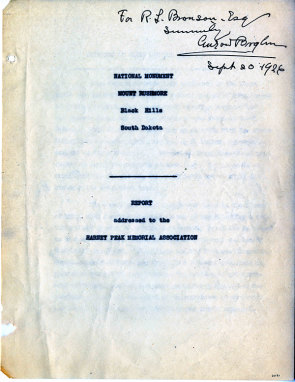Building Mount Rushmore, 1926
A Spotlight on a Primary Source by Gutzon Borglum
 This September 1926 report by the sculptor Gutzon Borglum to the Harney Peak Memorial Association anticipates the construction of the Mount Rushmore National Memorial in the Black Hills of South Dakota. Borglum’s report offers a look into the memorial’s conception and development as well as the artist’s vision of it as a testament to the development of the United States and the men responsible for it: George Washington, Thomas Jefferson, Abraham Lincoln, and Theodore Roosevelt. Borglum declared, “These four I, therefore, urge upon your Association as the characters to be adopted to memorialize symbolically that spirit which conceived, built, preserved, understood the need and the natural limits of our national dimensions.”
This September 1926 report by the sculptor Gutzon Borglum to the Harney Peak Memorial Association anticipates the construction of the Mount Rushmore National Memorial in the Black Hills of South Dakota. Borglum’s report offers a look into the memorial’s conception and development as well as the artist’s vision of it as a testament to the development of the United States and the men responsible for it: George Washington, Thomas Jefferson, Abraham Lincoln, and Theodore Roosevelt. Borglum declared, “These four I, therefore, urge upon your Association as the characters to be adopted to memorialize symbolically that spirit which conceived, built, preserved, understood the need and the natural limits of our national dimensions.”
Borglum’s report also asserted that Mount Rushmore’s favorable location and unique granite would ensure successful construction and future sustainment compared to the inadequacies the site originally, the Needles of the Black Hills. He estimated that it would take a budget of $460,000 and five years to complete the memorial. Those figures proved to be gross underestimates—especially considering Borglum’s original plans to include a tableau of American expansionist achievements and sculptures extending to the waist of each figure—and the memorial ultimately took 400 workers, fourteen years (from 1927 to 1941), and nearly a million dollars to complete.
Despite setbacks, delays, and budget problems in its construction, Borglum’s memorial at Mount Rushmore still stands as one of the greatest achievements in engineering history and is a historic landmark of American ingenuity and imagination.
